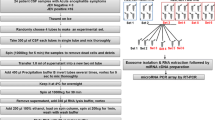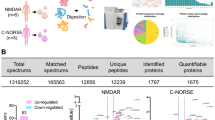Abstract
The study aimed to investigate the expression and significance of the plasma let-7 family in anti-N-methyl-d-aspartate receptor (NMDAR) encephalitis. Blood samples from 5 anti-NMDAR encephalitis patients and 5 negative controls were collected for microarray analysis. Blood samples from10 anti-NMDAR encephalitis patients, 10 anti-NMDAR encephalitis patients whose physical conditions have improved after 3 months of immunotherapy, 20 virus (meningitis) encephalitis patients, 20 tuberculosis (meningitis) encephalitis patients, 10 purulent (meningitis) encephalitis patients, 20 cerebral cysticercosis patients, 20 ischemic stroke patients, 20 intracerebral hemorrhage patients, 15 neuromyelitis optica patients, 15 multiple sclerosis patients, 15 moyamoya disease patients, and 20 negative controls were collected for real-time quantitative PCR (qRT-PCR) analysis. The expression levels of let-7a, let-7b, let-7d, and let-7f were significantly down-regulated in anti-NMDAR encephalitis compared with the negative controls (NC). The expression levels of let-7a, let-7d, and let-7f were significantly down-regulated in other nervous system diseases compared with the NC group while the expression level of let-7b was statistically insignificant in other nervous system diseases compared with the NC group. In addition, there was no significant dysregulation of let-7b in the anti-NMDAR encephalitis treatment group compared with the NC. Let-7b may be a potential diagnostic marker and an indicator that reflected the molecular mechanism of anti-NMDAR encephalitis.







Similar content being viewed by others
References
Bao MH, Feng X, Zhang YW et al (2013) Let-7 in cardiovascular diseases, heart development and cardiovascular differentiation from stem cells. Int J Mol Sci 14(11):23086–23102
Bernis ME, Oksdath M, Dupraz S et al (2013) Wingless-type family member 3A triggers neuronal polarization via cross-activation of the insulin-like growth factor-1 receptor pathway. Front Cell Neurosci 7:194
Chapman MR, Vause HE (2011) Anti-NMDA receptor encephalitis: diagnosis, psychiatric presentation, and treatment. Am J Psychiatry 168(3):245–251
Dalmau J, Tuzun E, Wu HY et al (2007) Paraneoplastic anti-N-methyl-D-aspartate receptor encephalitis associated with ovarian teratoma. Ann Neurol 61(1):25–36
Dalmau J, Gleichman AJ, Hughes EG et al (2008) Anti-NMDA-receptor encephalitis: case series and analysis of the effects of antibodies. Lancet Neurol 7(12):1091–1098
Dalmau J, Lancaster E, Martinez-Hernandez E et al (2011) Clinical experience and laboratory investigations in patients with anti-NMDAR encephalitis. Lancet Neurol 10(1):63–74
Evoli A, Spinelli P, Frisullo G et al (2012) Spontaneous recovery from anti-NMDAR encephalitis. J Neurol 259(9):1964–1966
Gable MS, Sheriff H, Dalmau J et al (2012) The frequency of autoimmune N-methyl-D-aspartate receptor encephalitis surpasses that of individual viral etiologies in young individuals enrolled in the California encephalitis project. Clin Infect Dis 54(7):899–904
Gao Y, Meng H, Liu S, et al (2014) LncRNA-HOST2 regulates cell biological behaviors in epithelial ovarian cancer through a mechanism involving microRNA let-7b. Hum Mol Genet Oct 6 [Epub ahead of print]
Guo L, Zhao RC, Wu Y (2011) The role of microRNAs in self-renewal and differentiation of mesenchymal stem cells. Exp Hematol 39(6):608–616
Guo Y, Yan KP, Fang JS et al (2013) Let-7b expression determines response to chemotherapy through the regulation of cyclin D1 in glioblastoma. J Exp Clin Cancer Res 32(1):1–10
Hou W, Tian Q, Steuerwald NM, Schrum LW et al (2012) The let-7 microRNA enhances heme oxygenase-1 by suppressing Bach1 and attenuates oxidant injury in human hepatocytes. Biochim Biophys Acta 1819(11–12):1113–1122
Inui M, Martello G, Piccolo S (2010) MicroRNA control of signal transduction. Nat Rev Mol Cell Biol 11(4):252–263
Irani SR, Bera K, Waters P et al (2010) N-methyl-d-aspartate antibody encephalitis: temporal progression of clinical and paraclinical observations in a predominantly non-paraneoplastic disorder of both sexes. Brain 133(6):1655–1667
Jiang L, Liu XQ, Chen ZJ et al (2010) MicroRNA-7 targets IGF1R (insulin-like growth factor 1 receptor) in tongue squamous cell carcinoma cells. Biochem J 432:199–205
Jin XF, Wu N, Wang L, Li J (2013) Circulating microRNAs: a novel class of potential biomarkers for diagnosing and prognosing central nervous system diseases. Cell Mol Neurobiol 33(5):601–613
Kang W, Tong JH, Lung RW et al (2014) let-7b/g silencing activates AKT signaling to promote gastric carcinogenesis. J Transl Med 12:281
Kehoe LA, Bernardinelli Y, Muller D (2013) GluN3A: an NMDA receptor subunit with exquisite properties and functions. Neural Plast 2013:145387
Kim DJ, Linnstaedt S, Palma J et al (2012) Plasma components affect accuracy of circulating cancer-related microRNA quantitation. J Mol Diagn 14(1):71–80
Laine SK, Hentunen T, Laitala-Leinonen T (2012) Do microRNAs regulate bone marrow stem cell niche physiology? Gene 497(1):1–9
Lehmann SM, Kruger C, Park B et al (2012) An unconventional role for miRNA: let-7 activates Toll-like receptor 7 and causes neurodegeneration. Nat Neurosci 15(6):827–835
Li YF, Peng T, Wang XH et al (2014) A primary study on down-regulated miR-9-1 and its biological significances in methylmalonic acidemia. J Mol Neurosci 53(2):280–286
Long GW, Wang F, Li HP et al (2013) Circulating miR-30a, miR-126 and let-7b as biomarker for ischemic stroke in humans. BMC Neurol 13(1):1––22
Malter MP, Elger CE, Surges R (2013) Diagnostic value of CSF findings in antibody-associated limbic and anti-NMDAR-encephalitis. Seizure 22(2):136–140
Marson A, Levine SS, Cole MF et al (2008) Connecting microRNA genes to the core transcriptional regulatory circuitry of embryonic stem cells. Cell 134(3):521–533
Melton C, Judson RL, Blelloch R (2010) Opposing microRNA families regulate self-renewal in mouse embryonic stem cells. Nature 463(7281):621–626
Miya K, Takahashi Y, Mori H (2014) Anti-NMDAR autoimmune encephalitis. Brain Dev 36(8):645–652
Nikaki A, Piperi C, Papavassiliou AG (2012) Role of microRNAs in gliomagenesis: targeting miRNAs in glioblastoma multiforme therapy. Expert Opin Investig Drugs 21(10):1475–1488
Nolan B, Plenk K, Carr D (2014) Anti-N-methyl-d-aspartate receptor (anti-NMDAR) encephalitis presenting to the emergency department with status epilepticus. CJEM 16(5):425–428
Petri R, Malmevik J, Fasching L et al (2014) miRNAs in brain development. Exp Cell Res 321(1):84–89
Polikepahad S, Knight JM, Naghavi AO et al (2010) Proinflammatory role for let-7 microRNAS in experimental asthma. J Biol Chem 285(39):30139–30149
Pruss H, Dalmau J, Harms L et al (2010) Retrospective analysis of NMDA receptor antibodies in encephalitis of unknown origin. Neurology 75(19):1735–1739
Rijavec M, Korosec P, Zavbi M et al (2014) Let-7a is differentially expressed in bronchial biopsies of patients with severe asthma. Sci Rep 4:6103
Roush S, Slack FJ (2008) The let-7 family of microRNAs. Trends Cell Biol 18(10):505–516
Schonrock N, Matamales M, Ittner LM et al (2012) MicroRNA networks surrounding APP and amyloid-beta metabolism—implications for Alzheimer’s disease. Exp Neurol 235(2):447–454
Siebert M, Westbroek W, Chen YC et al (2014) MiRNAs and glucocerebrosidase: lessons from miRNA mimic screening. Mol Genet Metab 111(2):S98–S98
Solomon A, Mian Y, Ortega-Cava C et al (2008) Upregulation of the let-7 microRNA with precocious development in lin-12/Notch hypermorphic Caenorhabditis elegans mutants. Dev Biol 316(2):191–199
Thornton JE, Gregory RI (2012) How does Lin28 let-7 control development and disease? Trends Cell Biol 22(9):474–482
Tzatsos A, Bardeesy N (2008) Ink4a/Arf regulation by let-7b and Hmga2: a genetic pathway governing stem cell aging. Cell Stem Cell 3(5):469–470
Valentinis B, Baserga R (2001) IGF-I receptor signalling in transformation and differentiation. Mol Pathol 54(3):133–137
Wang H (2014) Diagnosis and differential diagnosis of anti-N-methyl-D-aspartate receptor encephalitis in children. Chin J Contemp Pediatr 16(6):578–583
Wang J, Liu L, Song Z (2013) Clinical profile of anti-NMDAR encephalitis in patients of China. J Neurol Sci 333(Suppl 1):e633
Wulczyn FG, Smirnova L, Rybak A et al (2007) Post-transcriptional regulation of the let-7 microRNA during neural cell specification. FASEB J 21(2):415–426
Xu D, Tan JX, Zhou M et al (2012) Let-7b and microRNA-199a inhibit the proliferation of B16F10 melanoma cells. Oncol Lett 4(5):941–946
Xu H, Liu C, Zhang Y, et al (2014) Let-7b-5p regulates proliferation and apoptosis in multiple myeloma by targeting IGF1R. Acta Biochim Biophys Sin (Shanghai) 965–972
Zhao C, Sun GQ, Li SX et al (2010a) MicroRNA let-7b regulates neural stem cell proliferation and differentiation by targeting nuclear receptor TLX signaling. PNAS 107(5):1876–1881
Zhao JJ, Lin JH, Lwin T et al (2010b) microRNA expression profile and identification of miR-29 as a prognostic marker and pathogenetic factor by targeting CDK6 in mantle cell lymphoma. Blood 115(13):2630–2639
Zhou Q, Sheng M (2013) NMDA receptors in nervous system diseases. Neuropharmacology 74:69–75
Acknowledgments
This research was supported by grants from the National Natural Science Foundation of China (81071114; 81371385).
Conflict of Interest
The authors declare that they have no competing interests.
Author information
Authors and Affiliations
Corresponding author
Rights and permissions
About this article
Cite this article
Zhang, J., Xu, X., Zhao, S. et al. The Expression and Significance of the Plasma Let-7 Family in Anti-N-methyl-d-aspartate Receptor Encephalitis. J Mol Neurosci 56, 531–539 (2015). https://doi.org/10.1007/s12031-015-0489-6
Received:
Accepted:
Published:
Issue Date:
DOI: https://doi.org/10.1007/s12031-015-0489-6




